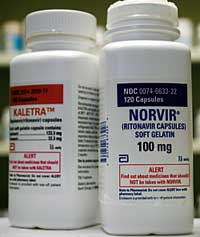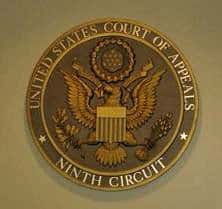 This step forward in equality comes to us courtesy of a fight between pharmaceutical companies. SmithKline Beecham and Abbott Labs both make HIV medications. SmithKline alleges that Abbott performed a little bait-and-switch: it allowed SmithKline to include Abbott's new HIV drug in its cocktail, but then quadrupled the price so as to make SmithKline's drug combination much less attractive than Abbott's own cheaper therapy. Fast forward to the trial on this allegation and Abbott wants the only openly identified gay person off the jury.
This step forward in equality comes to us courtesy of a fight between pharmaceutical companies. SmithKline Beecham and Abbott Labs both make HIV medications. SmithKline alleges that Abbott performed a little bait-and-switch: it allowed SmithKline to include Abbott's new HIV drug in its cocktail, but then quadrupled the price so as to make SmithKline's drug combination much less attractive than Abbott's own cheaper therapy. Fast forward to the trial on this allegation and Abbott wants the only openly identified gay person off the jury.
Abbott's lawyers are not being hateful here. HIV health care is of particular concern to the gay community and they want an unbiased jury. The law even allows each side of a jury trial a certain number of what are called "peremptory challenges," or strikes to the jury pool. But you cannot strike someone for an illegitimate reason. A famous case every law student learns called Batson v. Kentucky held that you cannot strike a potential juror from the pool simply on the basis of race. Batson was a criminal case, but the rule has been extended to civil cases like SmithKline's.
So the question was whether the Batson rule applied to sexual orientation.
The Ninth Circuit not only said yes — you cannot strike a juror simply because he is gay — it took us through step by step: First, striking a juror on the basis of sexual orientation implicates unequal treatment. Second, unequal treatment on the basis of sexual orientation merits heightened scrutiny. Third, under that standard, striking a gay juror violates equal protection.
This decision should strike us as just. Being gay has no bearing on your ability to be impartial, to consider the facts, and apply the law. To suggest otherwise burdens our identity with insidious stereotypes and lends institutional support to continued discrimination.
But the court's heightened scrutiny analysis was particularly notable. If you recall, we've discussed heightened scrutiny many times, most in the DOMA and marriage equality context. They speak directly to how a court will analyze a given instance of discrimination. Note that not all discrimination is bad; we discriminate against young people by not allowing them to vote or drive until a certain age. Scrutiny levels tell us how much work the government has to do to justify its discriminatory behavior. They are like hurdles on a race track — the higher the hurdle, the fewer runners are going to make it over and make the team. Similarly, the higher the level of scrutiny, the harder it will be for a discriminatory law to pass constitutional muster.
Many scholars believe that discrimination on the basis of sexual orientation demands heightened scrutiny. We meet all the requirements: we have been burdened by discrimination for generations, our sexuality is irrelevant to our ability to serve as jurors, we have traditionally lacked the political power to realize our full rights in the political sphere, and we have a defining characteristic essential to our identity as a group.
 But the Ninth Circuit went a step further and argued that the Supreme Court's Windsor decision suggests that heightened scrutiny is appropriate. Review in Windsor, the Ninth Circuit wrote, was not the traditional lowest form of review that had for years been applied to anti-gay discrimination. It was something more, something higher, something "intermediate."
But the Ninth Circuit went a step further and argued that the Supreme Court's Windsor decision suggests that heightened scrutiny is appropriate. Review in Windsor, the Ninth Circuit wrote, was not the traditional lowest form of review that had for years been applied to anti-gay discrimination. It was something more, something higher, something "intermediate."
How could the Ninth Circuit justify this conclusion if Windsor never explicitly said it was using heightened scrutiny?
The argument is simple: Look at what the Court actually did, not what it said. In Lawrence v. Texas, for example, the Supreme Court was similarly confounding, but by looking at the Court's decision, it was clear it was not using traditional rational basis. After all, the state had to do more justifying and the cases Lawrence relied on also used something more than rational basis. The same was true for Windsor. The state had to do a lot of work to justify DOMA, the precedent Windsor cited all used more than rational basis, and the Windsor Court did not go through a list of possible rational justifications for DOMA, all of which would normally be the case in a standard rational basis case.
Although I agree that heightened scrutiny should be applied to anti-gay discrimination, there is something missing in the Ninth Circuit's decision. Just because Windsor used something more than rational basis does not necessarily mean it used heightened scrutiny. Many scholars identified a new tier of review in Lawrence, which was used in Windsor, and called it "rational basis plus" or "rational basis with bite." It's tenuous to exist in this unjustifiable limbo between rational basis and heightened scrutiny, but the Ninth Circuit has nonetheless failed to make the jump.
If the Ninth Circuit's opinion catches on, if sexual orientation discrimination gets heightened scrutiny post-Windsor, our battle is more than half over. It is hard to justify banning us from the institution of marriage under rational basis review; heightened scrutiny takes away all doubt.
***
Follow me on Twitter: @ariezrawaldman
Ari Ezra Waldman is a professor of law and the Director of the Institute for Information Law and Policy at New York Law School and is concurrently getting his PhD at Columbia University in New York City. He is a 2002 graduate of Harvard College and a 2005 graduate of Harvard Law School. Ari writes weekly posts on law and various LGBT issues.



